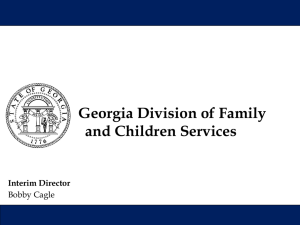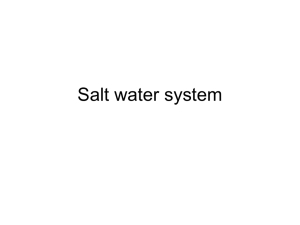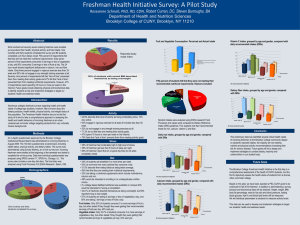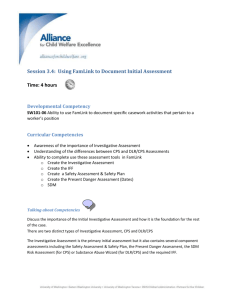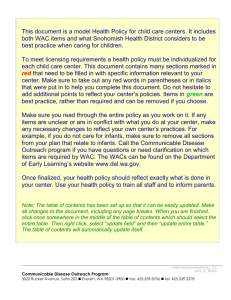2.2 Getting Started in Intake and CPS Process PPT
advertisement
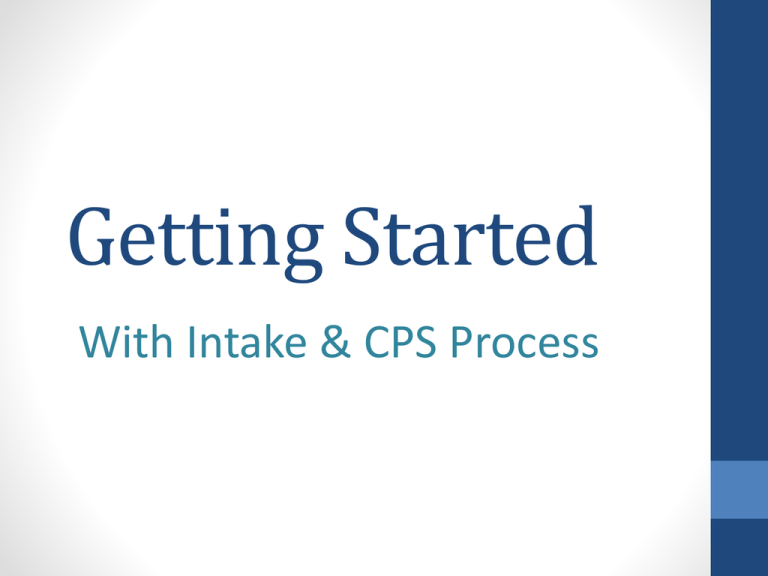
Getting Started With Intake & CPS Process Developmental Competencies SW104-01 Understands the roles and tasks of the intake process SW104-02 Understands level prioritization during the referral process including the ability to identify when a referral qualifies as an emergency and requires immediate attention SW104-04 Knows to gather information that may identify the child as an Indian or Tribal member SW106-01 Ability to use a solution based casework approach when conducting child maltreatment investigations SW107-01 Knows and understands the procedural differences between the investigative pathway and the family assessment response (FAR) pathway. Learning Outcomes Participants will be able to: • • • • • • • • • Cite the legal criteria (WAC 388-15-009 and WAC 388-15-011) for screening intakes Describe the roles and tasks of the intake process List the steps identified for Intake Describe the three types of intakes. Identify additional contacts, indicators and resources that an intake worker may use in their assessment Gather information that may identify the child as an Indian or Tribal member Identify everyday life events for and how they fit in the life of a family and a case Explain the procedural differences between the investigative pathway and the family assessment response (FAR) pathway. Complete an Intake document Basics of Intake Intake Functions • Accept calls and written reports • Document every contact • Screen reports & determine CA response • Gather additional information when able • Initiate social worker responses after hours • Second screening by supervisor Types of Intakes CPS Intake • Allegation of CA/N against • Parent (w/ or w/o other named subject) • Person acting in-loco parentis • SW assesses for child safety AND investigates the allegation CPS – Risk Only • No allegation of CA/N • Child may need immediate protection • SW assesses for child safety Intake and Initial Screening • • • • Intake sufficiency screen Intake meets the definition CA/N CPS response pathway decision tree Criteria met for either Investigative or FAR pathway CPS Responses Disposition of the Intake • Screen in – Emergent • Immediate safety concern • Screen in – Non Emergent • No immediate safety threat • Family Assessment Response (FAR) • Voluntary, offer of assistance • Screen out – “Info Only” • Documented in FamLink • No agency action Understanding CA/N using Family Development • Developmental Stages have certain necessary tasks • Everyday Life Events • CA/N = EDLE gone wrong or not achieved Planning for Investigation • Review history • Worker safety considerations • Tribal/ethnicity matters • Interview arrangements • Evidence gathering • Shared decision making Legal Foundation for CPS Investigation RCW 26.44.030 & WAC 388-15.029 • Collaboration with Law Enforcement (4) • Must notify of all CPS Intakes • Access to confidential information (7) • Full access to info about the child • Can exchange with mandated reporters • Also covered in WAC 388-15-029 • Ability to interview children (12) • At any suitable location • Away from parents • Parental notification ASAP, if safe • With a 3rd party present if possible Legal Foundation for CPS Investigation RCW 26.44.030 & WAC 388-15.029 Ability to conduct background checks (14) Requirement to use risk assessment (13) ◦ Substance abuse must be risk factor Ability to photograph Children (WAC 388.15.021) Client’s rights (RCW 26.44.100) ◦ Notify subject of allegations at initial contact ◦ Notify subjects of finding and of right to appeal Typical Sequence of Interviews for CPS Investigations • Referent • Victim child, siblings • Non-maltreating caregiver • Subject • Other adults in home • Collaterals Initial Contact With the FAR Path • Initializing engagement and assessment • Contact source of referral • Case preparation • Contact parents/caregivers to schedule meeting/visit Initial Visit and Assessment • Present danger assessment • Explanation of FAR pathway • FAR agreement with family • FAR Family Assessment • Safety Assessment • SDM Regarding Advance Notice… •To call or not to call, that is the question. • So, what is the answer? CAPTA Findings • Evidentiary Standard: • “more likely than not” • preponderance of evidence • 51% probability • Options: Founded or Unfounded • Right to appeal Findings within 30 calendar days of receipt of CAPTA letter. • 60 days to enter a finding. Review: Developmental Competencies SW104-01 Understands the roles and tasks of the intake process SW104-02 Understands level prioritization during the referral process including the ability to identify when a referral qualifies as an emergency and requires immediate attention SW104-04 Knows to gather information that may identify the child as an Indian or Tribal member SW106-01 Ability to use a solution based casework approach when conducting child maltreatment investigations SW107-01 Knows and understands the procedural differences between the investigative pathway and the family assessment response (FAR) pathway. Review: Curricular Competencies • Awareness of the legal criteria (WAC 388-15-009 and WAC 388-15-011) for screening intakes • Understands the roles and tasks of the intake process • Knows the steps identified for Intake • Knows the three types of intakes. • Can identify additional contacts, indicators and resources that an intake worker may use in their assessment • Knows to gather information that may identify the child as an Indian or Tribal member • Ability to to identify everyday life events for and how they fit in the life of a family and a case • Knows and understands the procedural differences between the investigative pathway and the family assessment response (FAR) pathway. • Participants will be able to understand how to fill out an Intake document Thank You
